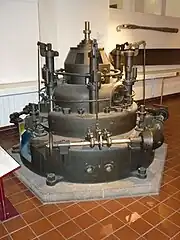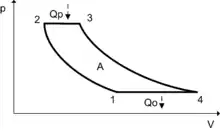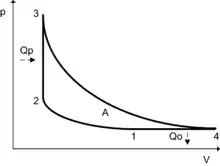| Thermodynamics |
|---|
 |
|
Pressure gain combustion (PGC) is the unsteady state process used in gas turbines in which gas expansion caused by heat release is constrained. First developed in the early 20th century as one of the earliest gas turbine designs, the concept was mostly abandoned following the advent of isobaric jet engines in WWII.[1]
As an alternative to conventional gas turbines, pressure gain combustion prevents the expansion of gas by holding it at constant volume during the reaction, causing an increase in stagnation pressure. The subsequent combustion produces a detonation, rather than the deflagration used in most turbines. Doing so allows for extra work extraction rather than a loss of energy due to pressure loss across the turbine.
Several different variations of turbines use this process, the most prominent being the pulse detonation engine and the rotating detonation engine. In recent years, pressure gain combustion has once again gained relevance and is currently being researched for use in propulsion systems and power generation due to its potential for improved efficiency and performance over conventional turbines.[2][3][4]
History
Early history

Gas-powered turbines have been researched since the late 18th century, starting with John Barber's 1791 patent. Over a century later, Ægidius Elling built a turbine in 1903 which generated 11 bhp (8.2 kW), the first gas turbine to produce net positive work. In 1909, the first pressure gain combustion turbine was built by Hans Holzwarth. Initially operating at 200 bhp (147 kW), subsequent improvements to the engine increased its power output to 5000 bhp (3728 kW) by 1939. However, the aptly named Explosion Turbine would lose popularity among engineers and inventors as continuous combustion designs gained traction due to their use in jet engine prototypes.[5][1]
Renewed Interest
The concept of pulsed propulsion is neither new, nor exclusive to pressure gain combustion. In fact, the German V1 missile utilized a pulse jet operating at 45 Hz. During the space race, NASA's Project Orion concept utilized force from nuclear explosions ignited behind the spacecraft to generate thrust. This process is known as nuclear pulse propulsion and is stylistically similar to the pulse detonation engine.[6]

In the mid-20th century, US aeronautical scientists and engineers were trying to study the properties of detonation waves. To do this, a primitive rotating detonation chamber of created. This development became the basis for the rotating detonation engine, one of the leading PGC engine concepts, although it was largely ignored at the time due to its instability.[7]
However, as gas turbines are becoming more and more optimized, PGC research is now gaining traction in aircraft propulsion, power generation, and even rocket propulsion. In January 2008, a pulse detonation-powered plane completed its first flight as a cooperative project between the Air Force Research Laboratory and Innovative Scientific Solutions, a research and product development company. Currently, various organizations have developed working PGC engines (mostly RDEs), but none have been put to commercial use due to developmental challenges.[7][8][9]
Concept & Comparison to Convention Turbines
Overview of Conventional Turbines

The majority of gas turbines consist of an intake through which atmospheric air enters the turbine. The air is then pressurized through a compressor before mixing with fuel. The air-fuel mixture, also known as the working fluid, is combusted in a deflagration (a combustion reaction propagating at subsonic speed), which causes the mixture to expand in volume while maintaining constant pressure. Finally, the combustion product is ejected out of the exhaust to produce thrust. This process is known as the Brayton Cycle and has been used as the standard method of jet propulsion and turbine design for about a century.[10][11]
Humphrey Cycle

Contrasting against the Brayton Cycle used in most turbines, Pressure Gain Combustion is based on the Humphrey Cycle. Instead of an isobaric system in which gas volume expands as heat is added to the combustion chamber, the volume of working fluid stays constant as its pressure increases during combustion.[12] While the Brayton Cycle describes a subsonic deflagration, the Humphrey Cycle occurs in a detonation (A combustion reaction propagating at supersonic speed).[13] The reaction occurs so quickly that the mixture doesn't have time to expand, causing a pressure gain, before being ejected through the exhaust to produce thrust. The whole process occurs rapidly, and turbines will produce anywhere from 20 to 200 detonations per second.[14][15]
Because the working fluid is combusting at a constant volume, there is no pressure loss across the turbine, which increases the net work generated by each cycle. However, since work is done by a series of detonations, rather than a constant reaction generating thrust, the process is naturally more unsteady compared to a conventional turbine.[3][16]
Designs & Variations
Pulse Detonation Engine
The simplest modern PGC turbine is the Pulse Detonation Engine. Consisting of almost no moving parts, the PDE is externally similar to a ramjet, a type of jet engine without compressor fans that viable only at supersonic speeds. First, air enters the intake nozzle and travels directly to the combustion chamber to be mixed with injected fuel. There, the mixture is ignited while the front of the chamber closes, producing a detonation wave which both compresses and combusts the mixture, before the working fluid is ejected at supersonic speeds through the exhaust.[17][6]
Because of the engine's simplicity and anatomical similarity to ramjets and scramjets, pulse detonation engines can be implemented as a combined-cycle engine, which can improve the performance and reliability of ramjets. Conventional combined-cycle engines have complex moving parts that are essentially rendered useless at high speeds, an issue that PDE/ramjet drives will not have.[17][6]
Rotating Detonation Engine

Apart from PDEs, there exist multiple other PGC engine concepts, including Resonant Pulse Combustors, and Internal Combustion Wave Rotors to name a few. However, the majority of modern PGC research is concentrated around the rotating detonation engine (RDE), which aims to solve many of the issues encountered by PDEs.[3]
The main drawback of pulse detonation is the intermittent nature of the combustions. Not only is the reaction hard to control, but the intermittent combustion also loses power due to the time it takes to refuel the combustion chamber after purging, in which no thrust is produced.[17][6] The rotating detonation engine aims to address both these problems. While PDEs involve a series of repeating detonations to ignite batches of air that enter the combustion chamber, RDEs can circumvent this by utilizing a single detonation wave that rotates around the space in between concentric cylinders. A continuous air intake flows through the cylinders, which compresses and combusts as it passes through the rotating detonation wave. This eliminates the need to constantly produce detonations since it only uses a single cyclic detonation, and it allows for a steadier constant flow, instead of the pulsing thrust produced by PDEs.[18][19]
Applications & Technical Challenges
Propulsion
Modern chemical rockets still utilize deflagration reactions to generate thrust, which are getting increasingly optimized to their limits. As a result, pressure gain combustion engines, mostly RDEs, to garner significant attention as a possible method of improving rocket performance. Currently, pressure gain rocket engines are being researched by space agencies in multiple countries, including NASA and JAXA, as well as numerous universities and private companies.[9] Detonation propulsion, which is more energy efficient than conventional deflagration reactions, may increase efficiency by 5-10%, which can both reduce rocket mass and increase payload size.[20]
As mentioned previously, pressure gain turbines have also been researched and developed extensively for use in aircraft propulsion. Pressure gain combustion engines can both improve the performance and reduce the complexity of combined ramjet/scramjet engines through their shared design similarities. Furthermore, this may even allow PDE/RDE combined ramjets to be utilized at conditions unsuitable for conventional ramjets. In addition, pressure gain turbojets require significantly less complexity, especially in the compressors, compared to regular turbines. This will not only save resources in manufacturing but also allow for designs to produce higher thrust in smaller engines.[6][19]
Energy Generation
Apart from nuclear fission, natural gas contains the highest energy density of widely used fuels.[21] As such, to reduce carbon emissions, electricity-generating plants are increasingly turning to gas turbines from crude oil and coal. While conventional turbines generate large amounts of energy more efficiently than other fossil fuels, just as in aerospace, they are beginning to reach their limits.[22]
Similar to its potential use in propulsion, pressure gain combustion turbines can offer an improvement to gas power plants. In addition to better efficiency, RDEs can operate at much higher hydrogen concentrations, further improving performance because of hydrogen's higher energy density compared to petrochemicals. The relative simplicity of RDEs can also improve reliability and ease of maintenance, though that may be counterbalanced by the increased stress put on the engine by the process itself.[22]
Engineering and Implementation Challenges
While PGC offers improved performance and efficiency, there are serious flaws and challenges that researchers were initially unable to solve, preventing the technology from being widely used.
Since PDEs are effectively intermittent explosion drives, the cycle they run on is far more unsteady and harder to control than conventional turbines. This makes PDEs very difficult to integrate into airframes, as the high energy pulsing of the engine can cause the inlet to unstart and stop the reaction, in addition to putting high stress on the nacelle or any other adjacent parts. The noise from the exhaust is also a concern. In testing, the highly energetic detonations produced up to 122 dB at a distance of 3 m in a 20 Hz PDE. For scaled-up commercial units operating at higher power and frequency, noise pollution will be a serious issue if effective damping measures are not implemented.[6]
Moreover, due to the high energy required to initiate detonations, PDEs with shorter combustion chambers will need to utilize deflagration combustion at initial ignition and accelerate pressure waves through a process called Deflagration to Detonation Transition (DDT). This requires placing obstacles in the path of the deflagration wave to induce turbulent flow, which speeds up the wave but requires more complexity in the engine structure.[17]
While RDEs solve many of the problems encountered in PDEs, it isn't without its flaws. The constant flow of the engine, coupled with the need to sustain the detonation, requires a tremendous intake of air to be rapidly mixed with the fuel in a shorter distance than most PDEs, which are normally quite elongated. In addition, the stress placed on the engine by the detonation process was simply too much for the engine to withstand during the early years of development. However, advancements in material science and manufacturing processes have improved the feasibility of RDEs to the point where research and development is believed to be worthwhile by many organizations.[9][18][19]
See also
References
- 1 2 Escobar, Joe (2006-04-14). "Turbine Engine History". Aviation Pros. Retrieved 2023-10-21.
- ↑ "Pressure gain combustion". Frazer-Nash Consultancy. Retrieved 2023-10-21.
- 1 2 3 Paxson, Daniel E. (July 9, 2018). "Pressure Gain Combustion 101" (PDF). NASA. Retrieved October 16, 2023.
- ↑ Rankin, Brent A.; Fotia, Matthew L.; Naples, Andrew G.; Stevens, Christopher A.; Hoke, John L.; Kaemming, Thomas A.; Theuerkauf, Scott W.; Schauer, Frederick R. (January 2017). "Overview of Performance, Application, and Analysis of Rotating Detonation Engine Technologies". Journal of Propulsion and Power. 33 (1): 131–143. doi:10.2514/1.B36303. ISSN 0748-4658.
- ↑ "The Evolution of Gas Turbines From the First Designs to the Latest Environmentally Friendly Development Trends: Part 1 | Turbomachinery blog". blog.softinway.com. 2022-04-19. Retrieved 2023-10-26.
- 1 2 3 4 5 6 Sweeney, Joseph (December 5, 2009). "Pulse Detonation Engines" (PDF). www.colorado.edu. Retrieved October 29, 2023.
- 1 2 McAlpine, Kate (2017-03-30). "Rotating Detonation Engine: The Old Is New Again". Michigan Engineering News. Retrieved 2023-10-29.
- ↑ "Scaled Composites Long-EZ "Borealis"". National Museum of the United States Air Force™. Retrieved 2023-10-29.
- 1 2 3 "NASA's rotating detonation rocket engine posts record test results". New Atlas. 2023-01-31. Retrieved 2023-10-29.
- ↑ "3.7 Brayton Cycle". web.mit.edu. Retrieved 2023-10-23.
- ↑ "Power Turbine Thermodynamics". www.grc.nasa.gov. Retrieved 2023-10-23.
- ↑ Bulat, Pavel (March 13, 2014). "About the Detonation Engine". American Journal of Applied Sciences. 11 (8) – via ResearchGate.
- ↑ Machine, Smart (2021-11-06). "The Transition Of Deflagration To Detonation | Smart Machine Technologies". Smart Machine | SMT. Retrieved 2023-10-26.
- ↑ Wei, Lu (August 26, 2015). "Operation of a pulse detonation engine system at high frequency". Proceedings of the Institution of Mechanical Engineers, Part G: Journal of Aerospace Engineering. 230 (5): 886–894. doi:10.1177/0954410015601693.
- ↑ "Pulsed Detonation Engine – ISSI". Retrieved 2023-10-23.
- ↑ Gutmark, E. J. (2021-10-01). "Pressure gain combustion". Shock Waves. 31 (7): 619–621. doi:10.1007/s00193-021-01053-3. ISSN 1432-2153.
- 1 2 3 4 "Pulsed Detonation Engines". arc.uta.edu. Retrieved 2023-10-30.
- 1 2 "Dr. Venkat Raman on the Rotating Detonation Engine, the frightening-sounding technology of tomorrow". aero.engin.umich.edu. 2020-11-11. Retrieved 2023-10-30.
- 1 2 3 Zhou, Rui; Wu, Dan; Wang, Jianping (2016-02-01). "Progress of continuously rotating detonation engines". Chinese Journal of Aeronautics. 29 (1): 15–29. doi:10.1016/j.cja.2015.12.006. ISSN 1000-9361.
- ↑ Richards, Geo. A. (June 23, 2014). "New Developments in Combustion Technology, Part II: Step Change in Efficiency" (PDF). cefrc.princeton.edu. Retrieved October 22, 2023.
- ↑ "Energy density - Energy Education". energyeducation.ca. Retrieved 2023-10-31.
- 1 2 "NETL Advances Rotating Detonation-Wave Combustor Technology". netl.doe.gov. Retrieved 2023-10-31.